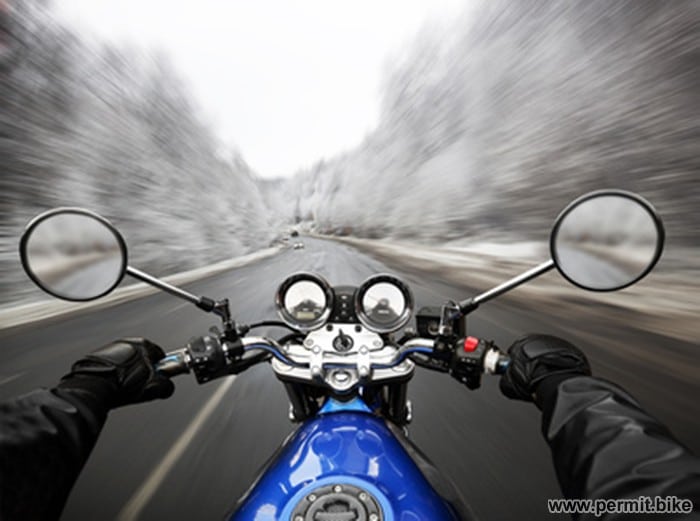Unless you are in one of those places that never seem to drop in temperature, you will have occasions to ride in the cold. So how do we prepare for those times? How should we layer up?
Before we discuss how to layer up, it’s important to understand a few basic concepts about cold weather riding.
First, when you are on the bike, the real feel temperature will be on an average 15 degrees colder than when you are standing still! That means a nice 50 F day will feel like 35 on the bike, almost freezing!
Although you may be able to tough it out, keep in mind your body plays a major role in controlling the bike. Hands and feet especially need to stay relatively warm to function properly. Keeping warm is more than just a consideration for comfort; it is also a huge safety concern.
So, let’s talk about layering up!
Where will you feel the cold?
The majority of us started riding in the warmer times of the year, and we bought gear accordingly. As we rode along into summer, and then fall, the days began to cool more and more. What was great gear for the summer days slowly become a lot less comfortable when winter hits.
So the first thing to pay attention to is where exactly do you feel the cold coming in as you ride? Do you feel a breeze working its way through the jacket, maybe around your zipper? Are your hands getting cold first? How about your head? You may not need to buy all your winter gear at once if you pay attention and slowly replace, or layer up, the areas that need it first.

Head
We lose 40 to 45% of our body heat through our head. Even if you are wearing a full-face helmet, you may quickly find that there are vents for cooling airflow that cannot be closed. Purchasing a good “winter helmet” is a great place to start. Pay attention to the vents, can they be closed? How well does it seal? First rule of thumb would be to lose the least amount of heat possible. Some riders purchase a full-face helmet just for winter riding.
Hands
I remember once I went on a long ride without proper gloves. I knew that the daytime would be warm, but the morning ride was freezing. My hands numbed to the point where I was no longer feeling them by the time we got to our destination. As they slowly thawed, I felt as if bamboo strips were being shoved under my fingernails!
Winter gloves are essential. Many of them are known as gauntlets because they cover the ends of your jacket sleeves, blocking air that could find a way into your jacket. Most winter gloves have either a glove liner or insulated padding. If you go to a good store, they should be able to tell you down to what temperature the different gloves will protect your hands.
Whatever you choose, make sure to keep your hands warm; you cannot control your motorcycle properly if you don’t.
Feet
Personally I have found that my riding boots are sufficient if I just add a nice pair of wool socks. However, one thing to keep in mind, cold by itself is not so bad, cold and wet can be downright miserable. Make sure your boots are waterproof in case you cannot avoid riding in wet weather.
Base layer
Now let’s move on to the rest of your body. You are trying to accomplish two things, keep your body heat in, and the cold air out! You can accomplish this with a good jacket and riding pants. However sometimes it’s best to be able to add or remove layers as the outside temperature can change rather quickly.
A base layer, such as a wool bottoms and top, is a great place to start. There are many products on the market that accomplish what you are looking for. Do your research, read the specific product information and reviews, and ask fellow riders what they use.
Outer layer
Your outer layer consists of pants and a jacket and should be made of a material that does not allow the wind to penetrate, like leather or a windproof textile.
In-between these layers you can add or subtract shirts, a fleece, etc, according to your needs. Make sure your winter riding jacket has enough room to accommodate the additional layers.
Finally, don’t forget your neck! I have found a good scarf can both keep my neck warm by closing the gap between my jacket and helmet, and provide an additional layer of protection on my chest; this will keep the wind from working through the zipper on my jacket.
Experiment – find the products that work for you! With a little forethought and planning, you can find just the right combination of clothing for any winter day.
Note: This blog covers what I consider essential winter riding gear – if you are really hardcore, or want to spend a lot of money, you can also invest in heated gear, but in my opinion, that is not essential.
My next blog will cover riding in different kinds of weather.
Until then; remember, ride safe, ride smart, and have fun!
David Ianetta was born and raised in Boston, MA. After moving around in his younger years, he now lives in North Carolina. David has a passion for riding motorcycles,often exploring the scenic back roads of NC with is wife, Rika, who rides her own along side him.
David also writes a Daily Blog for Freedom Biker Church called, “Daily Rock“ located at www.freedombikerchurch.com and is a contributing writer for Southeastern Rider magazine.
